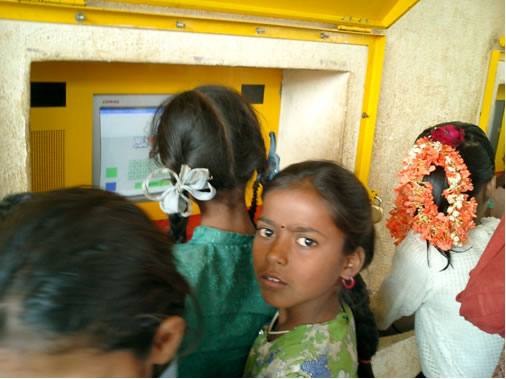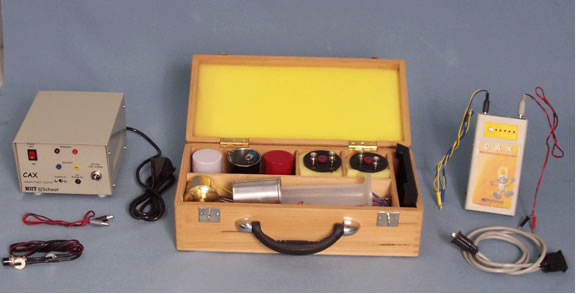|
New technologies on the Internet for self-organising systems in e-learning Sugata Mitra, Centre for Research in Cognitive Systems, the NIIT Institute Abstract
Technologies on the Internet are evolved rather than developed. It is this self-organising nature of the Internet that makes it different from more traditional developmental platforms. Most of the developments in traditional educational technology have happened in a “top-down” manner. Usually, an educator who is aware of technology would guess at what might be a useful educational application and then go about developing that idea. However, on the Internet, development seldom proceeds in this manner. Instead, new enabling platforms are created by people and then improved upon by others. Yet other people then decide what use such platforms can be put to. Networks of people, machines and ideas form and evolve to cater to some need of the same network. When a new idea or technology develops, it is interesting to observe how users learn to use it. Such learning needs to be efficient and fast because obsolescence is common on the Internet and an idea may have an “active life” of weeks or months. However, fortunes may be made or lost in those short durations. For example, when the programming platform called Dot Net began in the early years of the millennium, software developers needed to learn to use the use languages and tools rapidly in order to retain a competitive advantage over others. Training organizations had no time to react to the speed of the development of the new ideas. There was no time to make a curriculum, develop learning materials, and launch new courses. But a new breed of dot net programmers seemed to have emerged from nowhere. They had taught themselves the technology through newsgroups on the Internet. Threaded discussions, blogs, case studies, code samples had all come together from thousands of learners. A curriculum had emerged, although no one had planned it. A pedagogy had evolved and, due to necessity, had become extremely effective. This was ODL’s (open and distance learning’s) new face. Possibly a glimpse of the face of education itself in the near future. In this paper we will discuss the nature and possible applications of such emergent technologies on the Internet and in Information Technology in general. We will discuss this mainly in the context of primary and secondary education. THE EFFECTS OF REMOTENESS ON THE QUALITY OF SCHOOLS A world with Universal Primary Education (UPE) would be one where every child is educated. In order for that to happen it is assumed that every child would go to school. The current target year for this to happen, according to the UN, is 2015. Because “school” is equal to “education”. While this may undoubtedly be true, many may invert this equation to - “no school” is equal to “no education”. Education does not happen only through schools. Learning certainly does not. To examine the situation with schooling, we take India as an example. There are over 600,000 schools in India. While this is a large number, the population of India (currently 1.2 billion) is large enough to overcome it. There are 122 million children in India who do not go to school. In order to have the right number of schools for all children in India to go to school, we would need to triple the number of schools and the number of available teachers. That is, 1.2 million additional teachers would need to be trained. There is not enough money to do this, nor enough time, or management capability or institutions. The problem is just too large to solve with traditional, linear methods of scaling up. Let us, for a moment, assume that we could, somehow, build the necessary number of schools and train the necessary number of teachers, in time. We would suppose that all the schools we have built have a uniform level of quality, performance and efficiency. This cannot happen for the following reasons. Schools in remote areas do not have good enough:
In other words, the farther a school is from an urban area, the worse off it is. The quality of education from a remote school will usually be less than that from its urban counterpart. This is a human problem, not an economic one. After all, cities were built for comfort, safety, convenience and so on. So, people want to live in cities. Surely there are exceptions, but most people anywhere in the world tend to congregate towards cities and their suburbs. In the developing world, where rural and remote infrastructure is weak or non-existent, the problem is all the more acute. A recent survey in India (Pratham, 2005) shows that 51.9% of children aged 7-14 cannot read grade 2 texts and about 65.5% of these children cannot perform simple arithmetic operations. Schools with absent teachers or no teachers are abundant throughout Africa, India, South America and other large parts of the world. The more money spent on teacher development, the more they move to the cities. Without good teachers and administrators, the schools crumble and break. Children remain in schools, only on official records. The developed world is somewhat better off because their remote areas often have infrastructural facilities comparable to their cities. But only to a limited extent can that attract good teachers. A school in New Jersey will always have a wider choice of teachers, equipment and infrastructure than a school in Alaska, or even Newfoundland. The problem of quality will remain. It is in this context that we need to look for alternative methods for primary education that are relatively independent of teachers and infrastructure. Educational technology (ET) has traditionally been piloted and introduced first in good schools in urban areas (see for instance, Wenglinsky 1998 and Parr 2000). Since these areas have good teachers and (usually) good students, the performance of students is, in any case, good. Hence, not much improvement is noticed in learning, and the role of ET has often been questioned. Many teachers consider the use of technology in education as an over-hyped and under-performing idea. In view of this, I think that the most advanced educational technology should go first to the most disadvantaged learners. Any advantage to such a learner would be a benefit. For example, a learner in an urban school with good teachers may score 80% in some test of performance. A learner in a remote school with poor resources may score 30% (failed) in the same test. If the introduction of educational technology the urban learner increases the score to 90%, it may be considered too expensive for the value it provides. On the other hand if the same technology were to increase the scores for the disadvantaged learner to 40% (passed), it may be considered vital and very good value for money. A little improvement, at the “bottom of the pyramid” affects larger numbers, permanently. EDUCATIONAL TECHNOLOGY IN 2006 AND THE NEAR FUTURE Table 1 shows the present and future status of technologies that are, or have the potential to, affect the quality of education.
Table 1: Educational Technology matrix in 2006. We have divided the technologies into a 3-by-3 matrix. Three columns in the table marked A, B and C, lists technologies that are presently needed, those that have applications whose need is not felt or known to many educators, and those technologies that will be needed by educators of the future. Each column in table 1 is further divided into three rows marked 1, 2 and 3. These divide the technologies listed in each column into those that exist, those that can be developed and those where new methods have to be invented. This results in 9 “boxes”, each containing a shorter list of technologies. Each box in Table 1 needs to be treated differently.
Table 2 lists some of the different approaches that educators and researchers need to take for the different technologies listed in Table 1. The two tables together, therefore, represent a method for identifying and dealing with new technology as it appears. While space limitations do not allow us to describe each of the applications and technologies listed in Table 1, in what follows we will take a few examples of how this might happen. Example 1: Rural and Remote Education This is an example of a B3 type project, where technology has to be invented for an unknown need. In this case, the so-called “hole in the wall” experiments showed that groups of children, given access to shared, publicly accessible computers in playgrounds and other public areas, will teach themselves to use the technology on their own. We went on to discover that the “playground” computers would:
Through five years of rigorous measurements across the Indian subcontinent, his results were verified amongst 40,000 of the world’s poorest children. Almost half of these were girls. These results have been documented exhaustively (Mitra et al 2005). Minimally Invasive Education (MIE), as this method is sometimes referred to, is composed of several innovations in hardware technology, software technology, and cognitive design. It is one of the first attempts at applying the principle of self-organising systems to children’s education. Minimally Invasive Education Minimally Invasive Education (MIE) is new educational technology for achieving mass computer literacy, and some basic primary education at a cost that is considerably lower than traditional alternatives. It employs learning models such as collaborative constructivism and a series of interlocking innovations, both technological and pedagogical. Computers are made available in shared, public spaces, free of charge and no structure is imposed on when, how or what children learn. Example 2: Process control based laboratory tutoring systems This project is of B2 type, where technology can be developed for an unknown or unfelt need. We developed kits that can be connected to a computer and used by groups of children to conduct experiments is school Physics. The kits effectively remove the need for a Physics lab to a large extent. The computer is in physical control of the equipment and is able to monitor what the children are doing. For example, if the instructions are to heat a beaker of water, the computer is able to sense the amount of water and the amount of heat being generated. It also measures the temperature of the water and enables the children to plot this in real time as the water begins to boil.
Photo 3: Experimental setup for a specific heat experiment Example 3: Speech recognition based accent training systems This is a B1 type project, where existing technology is used to solve a problem that was not considered amenable to technological solution. We took a speech-to-text system and trained it to recognize a desirable accent. Groups of children were then encouraged to make their speech understandable to the computer. In effect, the children’s accents changed in a self-organised manner, unconsciously tending towards the desirable accent. The work is described in detail elsewhere (Mitra et al 2003). Example 4: Public domain video conferencing This is a project where existing technology is used for a purpose generally considered too expensive for regular use. While video conferencing has been used in distance education for a long time, it is considered to be of limited usefulness because of its expensive and technical complexity. We are experimenting with peer-to-peer (P2P) telephony (voice over IP, VOIP) and real time messaging systems to create a video conferencing environment that is almost free of cost. A combination of Skype, MSN messenger and some bandwidth can create an environment where an instructor anywhere in the world can have two-way, real-time, audio and video interaction with a group of learners. DISCUSSIONS AND SUGGESTIONS While much remains to be done to measure the effectiveness of educational methods that employ self organizing technologies on the Internet, certain possibilities are no longer speculative and can be discussed as possible learning methods. Collaborative, constructivist education is already happening amongst young people on the Internet, although there is little formal use of it by instructors and institutions. The technologies that are relevant to such learning are:
While this is by no means an exhaustive list, it does indicate the nature of self organized and self regulated instruction on the Internet. Such environments are actualized through devices that are mostly PCs, mobile phones and PDAs. All such devices are, as yet, designed for urban use and for affluent users. For an alternative universal primary education to emerge, it is necessary to develop technology that is capable of use in rural and remote areas. Alternative primary education of the future will have to be digital, automatic, fault-tolerant, minimally invasive, connected and self-organised. REFERENCES
Figures |


